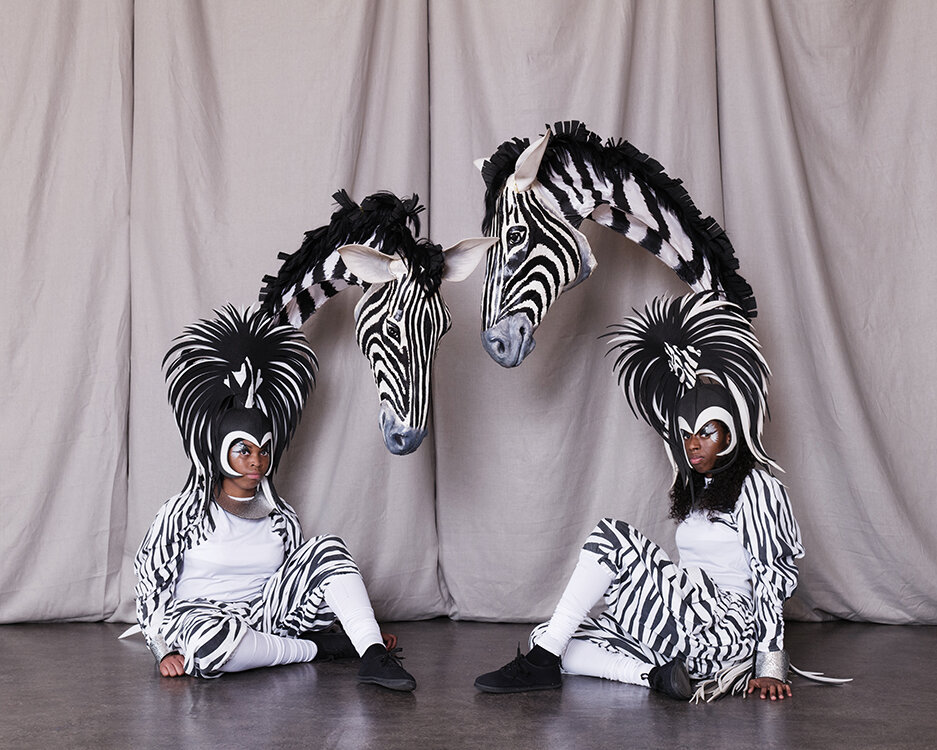Clary Salandy Is Keeping The History of Carnival Alive
Clary Salandy is one of the founders of Mahogany Carnival Design set up in 1989 by her and her husband, Michael Ramdeen aka Speedy. As the name would suggest, the company designs Carnival costumes, in the art form of “Mas Making” and they are known for their larger than life designs. The pair are both native to Trinidad and are designers in their own right; Clary studied at The Wimbledon School of Art and worked at Central St Martin’s in London, whilst Speedy studied Structural Engineering. They set up shop in Harlesden, North West London in 1996 and have been there ever since. “We’re very inspired by the art form and so we do everything we can to be as innovative as we can in our ideas [and] techniques.
““We’re very inspired by the art form and so we do everything we can to be as innovative as we can in our ideas [and] techniques.””
That's what Speedy is really excellent at, he’s an amazing engineer.” Mahogany's costumes are known for their extravagance and large scale, with costumes being up to 15 ft tall with all kinds of tricky mechanisms such as opening and closing, whilst being agile enough to be worn and maneuvered.“He’s very good at that sort of thing, he loves working like that and I love giving him complicated things to do. My work comes with lightness, with movement”, in the 50s they would use wire to make the costumes but foam was the material of the 70’s. “Now we use foam and fiberglass [so it’s] lighter. Costumes became different because of that”.
The Carnival costumes we see today are typically less structured, and consist mostly of feathers and beautiful adornments, this is known in the Caribbean as Pretty Mas. “One of the things about Carnival is it's about being free so I don't have the right to tell someone what their freedom looks like [but] I would not do it myself because I have read my history”. Clary wrote her dissertation on the ‘History of Trinidad Carnival’ and fully realised the dark history of Carnival which seems so distant to the jubilation we see on the streets of London come Bank Holiday August.
Carnival in the Caribbean began as an act of liberation. Originally, a religious festivity, an act of jolly and feasting before lent, when the traditions were brought to the Caribbean during the time of slavery and colonism, Black people were forbidden from taking part. Following the emancipation from slavery, Black people took to the street in celebration and masqueraded, renacting the horrors that they faced during their enslavement. “They had characters, with speeches, monologues and all kinds of things, it was really fascinating, but made it really clear to me, how lucky I am to be born when I was born, and I needed to pay homage to those people, and Carnival isn't about fun it was about collaboration of those people, that’s the point”.
“The first Carnival was the Carnival of Fire, they had a festival called Canboulay”. When fires broke out on plantations, the enslaved were forced into the fields to rescue the surrounding canes before they were burned and ruined. This act was reenacted at the first carnival, known as the Cannes Brûlées, meaning burnt canes in French, which later became known as Canboulay. The British authorities who ruled Trinidad at this time wanted to squash the expression of Black people on the island as well as any trace of African influence and in 1881, Canboulay was banned, leading to riots between Black People and British police.
““Police even banned drumming, which played a huge part in Canboulay celebrations which led to the invention of the steel pan. Another Caribbean staple and symbol of jubilation that was born out of resistance and rebellion.””
Of course, the origin of Notting Hill Carnival is not worlds apart from this. Following the destruction of World War II, hundreds of thousands of Commonwealth citizens, many of these from the Caribbean, were invited to Britain to work; on their arrival, they were met with racial hostility and intolerance. Not only were many right wing political parties openly promoting anti-immigration and white dominance, but there was ongoing violence from the Teddy Boys, a group of white working class youth, notorious for their racism towards Black migrants in Notting Hill. In August 1958, what is now known as the Notting Hill Race Riots began. Mobs of up to 400 white people stormed the Caribbean residents of the area, with petrol bombs, milk bottles being used as missiles, iron bars and butchers knives. These acts of terror persisted continuously for one week.
As a direct response, Claudia Jones, who is often referred to as the mother of Notting Hill Carnival, organised events to celebrate Caribbean culture in the face of the hate from the white racists. A "Caribbean Carnival" was held on 30 January 1959 in St Pancras Town Hall. In 1966 Notting Hill Carnival was born. Clary is extremely educated on the origins of Carnival and is passionate about keeping these stories alive. “That is the thing that’s really important about Carnival and the role we all have to play in carnival. How can I ignore that?''.
““This is where themes come into play, and the act of telling a story through Carnival design. The theme of Mahogany this year is “The Time For Change Is Now”.”
Clary shows me a headdress she designed, with a spiral of eyes that represent the many that have been murdered in cold blood. From Kelso Cochrane (1959), to Stephen Lawrence (1993), to George Floyd (2020). Clary has a political voice within her work, something that is not that common in today’s Carnival band leaders. “Some bands are led by somebody that's a band leader, they're not an artist… an artist, has a different approach. A band leader isn't creative, he’s an organiser, he's an administrator, he’ll go and find a designer somewhere and that's where the fun becomes more [important]”.
When Mahogany was set up, there was prevalence around the art form of Carnival design; “you could get a grant of £400 from the arts council, there was a system that was set up for young designers and a development course where you could go and learn how to make a backpack”. This dedication of the art is something that Clary would love to see put back in the future of Carnival.
““It deserves to be funded properly like a mainstream art form, that would make a huge difference to everything, to the quality, to the resources, to the way the audience are affected by it”.””
There have of course been a number of changes to Notting Hill Carnival since Clary’s early days. Not only were the bands much smaller, with perhaps 7 people per section and 30 people in a band but it was much more Caribbean led and dominated by Caribbean Culture. Whilst that influence still exists it has definitely become more London centric. Clary also recalls the spectacularity of Childrens Day, the parade that takes place on Sunday. “Childrens day used to be fantastic, lots of children [and] schools participating. There are schools participating now but not like they did before”. It's Important to pass on the history and traditions of Carnival to the next generation, she says and has been orchestrating carnival design workshops even prior to the creation of Mahogany. “We’re being creative and teaching young people [and] making sure we’re putting a strong message out”.
The hard work has paid off with the work and dedication of Mahogany Carnival Designs being recognised and appreciated all over the world. So much so that when I ask Clary what her proudest moment is, she struggles to pin one down “Oh my gosh!”, she exclaims, “that’s a hard question”. On a personal level, it’s seeing the next generation, her grandchildren, taking part in Carnival in costume, continuing down the customs. On a career level, she manages to narrow it down to two: performing in front of Buckingham Palace for the Olympics Handover Ceremony, “in front of the freaking queen!” and the Millennium Celebration in Singapore. “Could you imagine? We’re the finale in Singapore at their Millennium Celebration Parade! That’s a lovely affirmation of liking our stuff”.
Seeing the hard work and innovation that goes into Mahogany, it’s no surprise that they are critically acclaimed and recognised worldwide. Their work is spiritual, political and beautiful. Clary and Speedy are certainly creating a legacy with Mahogany Carnival Designs, and it is up to us to also continue telling these stories and keep the history and legacy of Carnival alive.
Follow Mahogany Carnival on Twitter here and Instagram @mahoganycarnival.
Virtual Notting Hill Carnival is streaming at www.nhcarnival.org
Credits: Written by Rochelle Thomas / Photography: Derrick Kakembo Set Design: Amelia Tavenner .
















